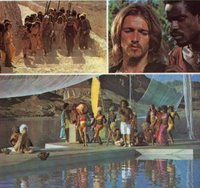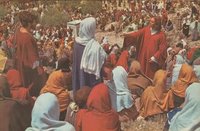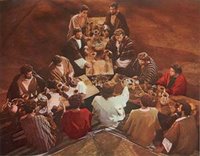Jesus, the Gospels, and Cinematic Imagination
A Handbook to Jesus on DVD
 Publisher: Westminster John Knox Press (2007)
Publisher: Westminster John Knox Press (2007)
Paperback: 208 pages
Language English
ISBN-10: 0664230318
ISBN-13: 978-0664230319
Product Dimensions: 22.4 x 16 x 1.8 cm
Additional Resources available online
As a result the authors Jeff Staley ("Reading with a Passion") and Richard Walsh ("Reading the Gospels in the Dark") have set about creating this guide to Jesus on DVD, which makes the best use of the new technology. Taking the 18 of the most important Jesus films available on DVD (see my earlier post for the full list) they have given a run down of all the DVD chapters, with each subdivided into a list of biblical episodes that occur in that chapter. These come complete with extensive biblical references, and precise timings, as well as a few additional comments. The book climaxes with the final chapter "A Gospels Harmony of Jesus Films on DVD" which the authors describe as the 'generative heart of our work'.2 Such a work is long overdue. Whilst aspects of it have been included in the appendices of previous works (notably Tatum, and Stern, Jefford and Debona) it's great to have something to help those who regularly find themselves trying to locate a particular biblical episode from a film, and finding that it takes a lot longer than they initially imagined.
Having said all that, the book offers far more than simply a collection of data. The eighteen chapters looking at the films themselves are bookended by two which are simply titled "Watching Jesus Films" and "Teaching Jesus Films". The former (which is excellent) lists various questions relating to the different aspects of film: Camera, Editing, Set, Lighting; Story, Plot, Causation; Characters; Genre, Tone, Ideology; and Motifs and Symbols. These themes then become, loosely speaking, the basis for which the 18 films are discussed in the main section of the book.
In contrast, the penultimate chapter ("Teaching Jesus Films") subdivides its subject matter into teaching using clips, teaching using a complete film, and Christ figure films. The first section discusses notable treatments of key incidents and characters in the films they have selected: the second offers 'topical suggestions' for 'a more holistic use of Jesus films' ranging from Peasant Faith and Capitalism to Queer Concerns.3
In addition to the DVD chapter listings, each of the 18 main chapters also contains a good deal of analysis. There's an opening plot summary, discussion about the film's memorable characters and visuals, and a handful of pertinent scriptures, all before brief discussions of the film's cultural location (or genre) and the film's director.
Of course, many of these areas have already been discussed in the various other volumes on Jesus in film, which makes it all the more impressive that Staley and Walsh are able to bring to the table so many fresh, and at times fascinating, insights. The authors are particularly adept at reading film visually, which is something that has been somewhat lacking in the library of Jesus film books to date.
The book is also eminently readable, and accessible to a far wider audience than Walsh's last book. "Reading the Gospels in the Dark", was most certainly interesting, but nevertheless quite difficult reading and not always entirely convincing. Here, non-specialists will feel at home, whilst those of us who are more experienced in this area will find plenty to chew on.
As always, there are a couple of minor quibbles. Firstly, I'm surprised that for the sake of completion the authors did not include details of all the versions of these films that are currently available DVD. Whilst the chapter listing would still have to focus on only one of these releases, this would certainly have enhanced the sections on DVD extra features, and would, no doubt, prove useful to readers who are keen to acquire some of the titles they did not have beforehand.
Secondly, the plot summaries are, at times a little long, often mentioning nearly every scene. Given that there is a full scene listing at the end of each chapter, these could have been a little briefer and given space for more of the authors' own observations.
But these are minor quibbles about a book that will prove invaluable to the growing numbers of people who lecture, teach and lead discussions on cinematic portrayals of Jesus. Staley and Walsh have brought an end to the hours spent in front of video (and indeed, DVD) machines trying to find a particular clip, and I, for one, am extremely grateful!
========
1 - Staley, Jeffrey L., and Walsh, Richard, "Jesus, the Gospels, and Cinematic Imagination: A Handbook to Jesus on DVD", Louisville / London, Westminster John Knox Press (2007), p.v (Preface)
2 - Staley, Jeffrey L., and Walsh, Richard, "Jesus, the Gospels, and Cinematic Imagination: A Handbook to Jesus on DVD", Louisville / London, Westminster John Knox Press (2007), p.vii (Preface)
3 - Staley, Jeffrey L., and Walsh, Richard, "Jesus, the Gospels, and Cinematic Imagination: A Handbook to Jesus on DVD", Louisville / London, Westminster John Knox Press (2007), p.167
Labels: Books































